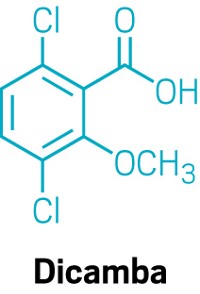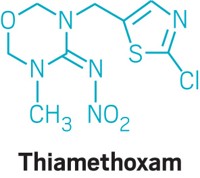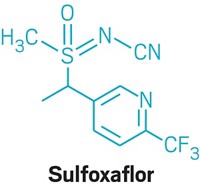Advertisement
Grab your lab coat. Let's get started
Welcome!
Welcome!
Create an account below to get 6 C&EN articles per month, receive newsletters and more - all free.
It seems this is your first time logging in online. Please enter the following information to continue.
As an ACS member you automatically get access to this site. All we need is few more details to create your reading experience.
Not you? Sign in with a different account.
Not you? Sign in with a different account.
ERROR 1
ERROR 1
ERROR 2
ERROR 2
ERROR 2
ERROR 2
ERROR 2
Password and Confirm password must match.
If you have an ACS member number, please enter it here so we can link this account to your membership. (optional)
ERROR 2
ACS values your privacy. By submitting your information, you are gaining access to C&EN and subscribing to our weekly newsletter. We use the information you provide to make your reading experience better, and we will never sell your data to third party members.
Environment
Rancor Over Pesticide Spraying In California
Pheromone-based product draws ire of residents in affected areas
by Elizabeth K. Wilson
November 6, 2007

Amid protests and legal battles, large swaths of the agriculturally intensive Monterey Bay and Santa Cruz areas in Northern California are being sprayed with pheromone-based pesticides in hopes of warding off an infestation of the crop-damaging light brown apple moth.

The controversy harks back to the 1980s and '90s, when attempts to wipe out the Mediterranean fruit fly in California with widespread aerial spraying of the pesticide malathion generated public outcry.
Last September, areas of Monterey County were sprayed for the light brown apple moth, and more spraying was scheduled to begin in Santa Cruz County on Nov. 5. Citizens groups and local governments have attempted several times to halt the spraying, saying the pheromones'??safety??in widespread human exposure has yet to be determined. On Nov. 5, a federal judge denied a temporary restraining order request filed by Santa Cruz County residents, and the spraying program was scheduled to resume on Nov. 6.
The action of the pesticides, which contain a mixture of insect pheromones, is vastly different from that of previous-generation pesticides such as malathion and other organophosphates, which indiscriminately wipe out any bug in their path. In this case, the pheromones are normally produced by female moths. An artificially applied source of the pheromones diverts the attention of the males, resulting in less mating and smaller moth populations. Insect pheromones were first identified in the late 1950s. They are now widely used in pest control and are the subject of international research.
"Our product doesn't kill???it confuses the male," says Kristin Ketner, director of R&D at Suterra, the Bend, Ore.-based company that produces varieties of the pesticide under the brand name CheckMate.
The light brown apple moth, which is native to Australia, is part of a group of "leafroller" pests. The larvae eat the leaves of plants. The California Department of Food & Agriculture declared an emergency after the moths were first discovered in traps last February, saying the pest could cause hundreds of millions of dollars in damage to numerous crops, including apples and grapes.
Last month, California Gov. Arnold Schwarzenegger ordered Suterra to make public the ingredients in CheckMate-LBAM-F, one of the pesticides. According to the company, the product contains two insect pheromones, identified in the 1980s to be (E)-11-tetradecen-1-yl acetate and (E,E)-9,11-tetradecadien-1-yl acetate. CheckMate-OLR-F, which was used in the September sprayings, contains similar ingredients, including the pheromone (E)-11-tetradecen-1-ol acetate.
Richard G. Vogt, biological sciences professor and director of graduate studies at the University of South Carolina, notes that the spraying strategy has worked well in small areas, but he has reservations about the effectiveness of widespread spraying of the pheromones. "It isn't used a lot on this scale," he says.





Join the conversation
Contact the reporter
Submit a Letter to the Editor for publication
Engage with us on Twitter